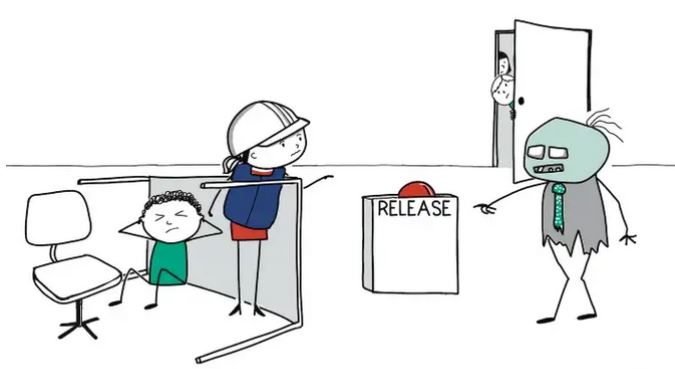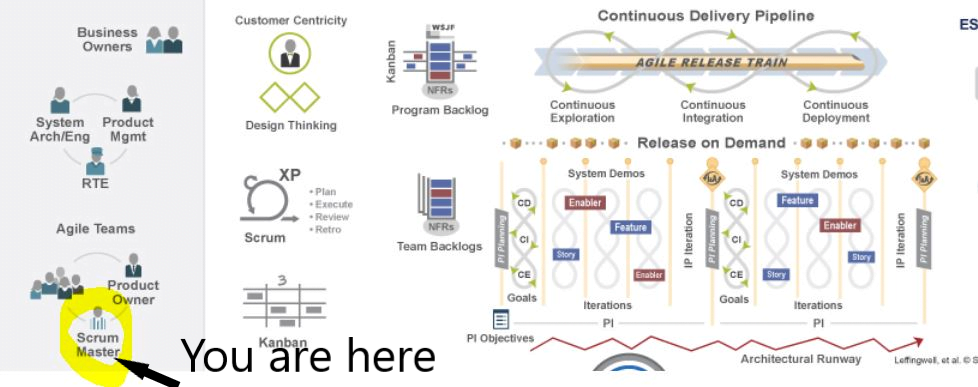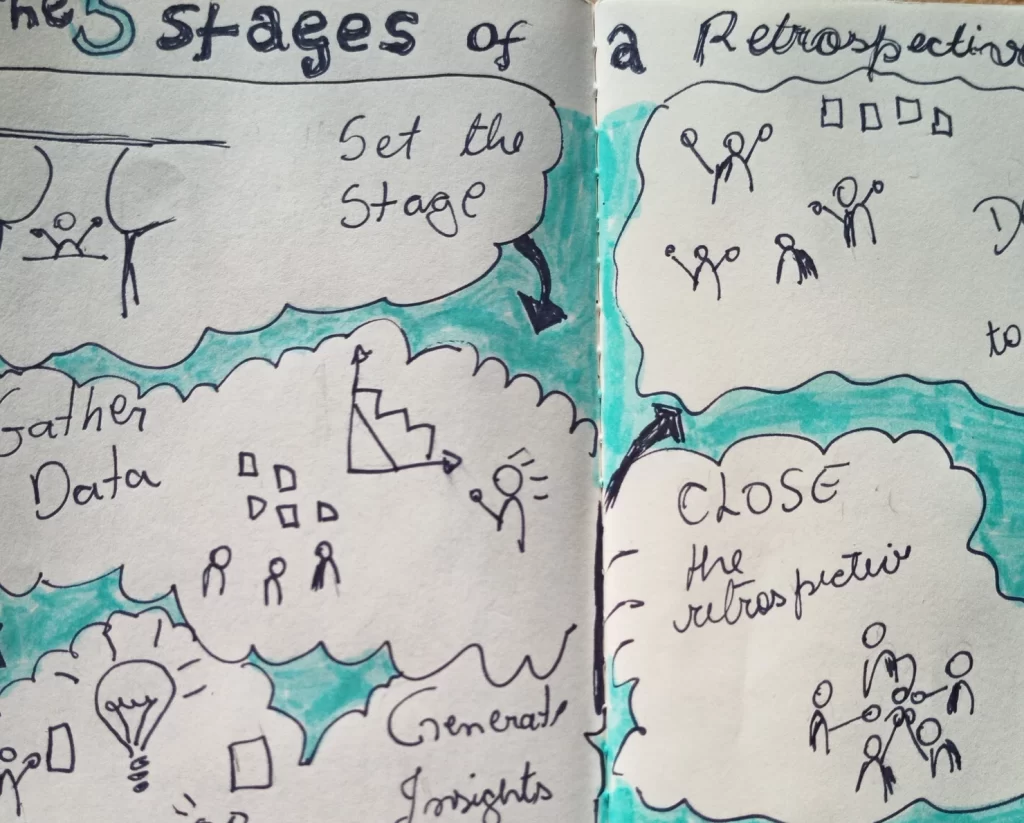This is not a bleak post nor a cautionary tale. Most Scrum Master jobs are a lie. Many times unintentionally. But still.
This is about you being happy and part of happiness is awareness. Most aspiring or beginner Scrum Masters may think the most difficult part is getting the job. But the reality is that you will fail if you consider the Scrum dream versus the Scrum reality of most organizations.
There are very few actual Scrum Master jobs out there.
In this post I’m going to explore with you some of those less-than-ideal scenarios where the dream of being hired as a Scrum Master turns a bit sour. Many beginner Scrum Masters fail on these scenarios, and I’ll share with you some tips on how not to be one of them.
I know you worked hard for that position. Maybe you got my book on Scrum, maybe you joined some community of practice. And now you finally got a position as a Scrum Master. It feels great!
Until it doesn’t. The reality and the expectations do not match. You are confused and deserted on what you thought was a great career choice.
It happened to me and to many others before you, so no need to feel ashamed or despair. Let’s dive into the 3 scenarios that are a lie as Scrum Master jobs and how not to fail on them.
1 – The organization does not know what they want or what a Scrum Master is
Sad, but true.

Agile have experienced such a growth in interest in the past 10 years that even domains beyond software development now adopt it, especially in the form of Scrum.
It sometimes feels every other company has FOMO and thinks they need the next agile miracle for growth and productivity. So, they do not operate in agile, yet they ask for a Scrum Master miracle-maker. Here’s some ways in which they perceive Scrum Masters:
- You are like a ninja project manager, who can come in and make any project agile.
- Some companies have toxic culture, poor teamwork and they want to delegate the improvement of this nightmare solely to you.
- They just installed Jira across the board and of course they need you, a Scrum Master, to manage it.
- You are like this team lead who has reporting and management duties, and also teaches people Scrum (on the side, because who has the time?).
- You might never have a planning session, run a daily Scrum, or see any signs of retrospectives taking place, or people find excuses to skip them.
These anomalies happen in small and big organizations, and in this scenario you are usually alone. No other Scrum Master in sight or an Agile Coach to support you. Precisely because of the lack of understanding of Scrum, let alone agile.
It is daunting and it is OK to feel uneasy. These scenarios have poor success outcome for anyone without a ton of experience, so don’t feel like you are a failure for struggling on the job. There are so many misconceptions to undo in a space like this that you might not have the mental or emotional capacity to last long enough.
So, just do your best. Let’s look at some ways in which you can get out of this situation.
What you could do before you get the job
- Research the company. LinkedIn, Indeed.ca, a good Google search and social media. See what appears about that company’s presence.
- Try and find people who worked there before. Do you know any of them? Can you interview them? Hearing first-hand accounts will paint a more accurate picture for you.
- In the interview process, ask if they have more than one Scrum Master or an Agile Coach in the company. It will tell you how invested they already are and as a bonus you might not be alone.
- In the interview, ask them to describe the day-to-day of a Scrum Master. Stop them at any activity that feel suspicious and ask for more details. Don’t be afraid to grill them. You are interviewing them just as much.
Make sure to know what the workplace is like when you agree to take that job. And if you want to pass this opportunity, there is no shame. Just say no.
What you could do after you get the job
- Every time you find activities that do not match with the role, tell your supervisor and try and discover the expectation behind it. don’t be shy in letting them know when a demand towards you is misaligned with the role. Managing expectations apply to both sides of this relationship.
- If they ask for something that you have the interest and competency in, still mention those are not Scrum Master attributions, explain why, and then mention you are still happy to do it. Your role as a Scrum Master should also be to educate the client, but ultimately you can all grow together, and you don’t need to do Scrum to help people.
- When you have conflicting responsibilities (project manager but the team is self organizing) or you have reporting duties, mention the conflict of interest and how it is damaging for everybody and how it makes you uncomfortable.
- Find an Agile Coach to help you occasionally or regularly.
2 – The organization enacts zombie scrum
Zombie Scrum is a term coined by The Liberators to illustrate that a team or (more likely) an entire organization goes through the motions of Scrum like doing the events, adopting the role, but not actually living the Scrum values and collecting the benefits that framework can bring.

In this scenario you might actually have a team that does Sprint planning, Daily Scrum, you might not be the only Scrum Master around the block.
I honestly find this scenario a bit better, because there is a foundation, albeit a weak one, for you to start with. When you are just starting out as a Scrum Master, it will make all the difference to have peers in the same role and be able to tweak and deepen the already existing concepts.
In zombie Scrum, you will probably see things like these:
- Teams get organized around sprints, but no potentially shippable product or feature is produced in the end of the sprint.
- Sprint retrospectives do not yield any relevant results and action items do not get follow up.
- Team and stakeholder organize mostly around tasks and instead of goals.
While the liberators have a whole book on the subject (this is not an affiliate link) I can give you some quick ideas on how to deal with the situation.
What you could do before you get the job
- When the job description and details seem great, you likely eliminated the previous scenario. But to identify elements of a Zombie Scrum, ask questions about how the organizational values align with the pursuit of agile and what motivated its adoption. In particular about Scrum. Ask about the support for teams and ask them to describe the current challenges teams, managers, and stakeholders face. That’ll paint the picture for you.
- If you have an opportunity, ask to meet with the team before you say yes, even if one or two team members. It’s an opportunity to get a feeling for their maturity but also your energy together and to ask those questions that sometimes recruiters just cannot help you with.
- And my favorite:
- Ask the team what they expect from you as a Scrum Master.
What you could do after you get the job
- Gauge the overall level of maturity and understanding of Scrum (and agile in general). Many times, not everything is wrong with the Scrum adoption, so that can help you gain clarity of where the gaps are. Rank the discrepancies from better to worst and if you are courageous, start with the worst. This is good for balancing things out.
- If you want to ease into things, do something different. Asses the team (and the organization) but identify the ONE thing you could address first that seems easier or that just gets you excited instead of afraid. In this case, you are privileging an easier, quick win to gain momentum.
- Example, if you have a particular love for retrospectives, start addressing with the team what it truly is, the helpful structure for a retrospective, the importance of follow up on the action items, etc. Once that starts feeling under control, do an assessment of what you’d like to do next.
- If you can, form a community of practice. It can be a Scrum community of practice, or it can be related to specific topics based on the Zombie Scrum parts you want to address. You want to start getting people involved in the change-making process and you want to start disseminating knowledge and invite others to do the same.
- Join forces with the other Scrum Masters if they are around. There is power in numbers, and you can start great initiatives together.
- If there is an Agile Coach, make sure to connect with her. They are instrumental in connecting your needs from your team with strategies that managers and other leadership circles might be planning.
3 – Frameworks that use the word Scrum are all different
The final scenario, very common since the surge in “agile transformations,” is you think you will work with a great autonomous teams, but actually you will enter the world of what I call messy Scrum.
You see, Scrum as prescribed by the Scrum guide is one thing . But some people decided it was a good idea to mix and match and build on top of Scrum to “scale things”. Great agile coaches and change agents know the best way to work change at scale is to de-scale change…

Nevertheless, you have SAFe, a favorite among huge organizations, Nexus and LeSS, that each use Scrum as foundation, but they orchestrate across several teams an throughout the organization. The list can go on, but these are just a few examples.
Why is this important?
Well, you might expect Scrum teams to have way more agency and maturity than they actually have in those “at scale” scenarios, especially SAFe. Somehow scaling the solution seem to limit autonomy, which is kind of counter-intuitive.
Also, operating in those “at scale” spaces can create narrow expectations of your role, especially on SAFe, where you will deal with RTEs and STEs doing coordinator-Scrum-Master type of jobs. By having other people calling the shots in the higher level, you are left in a position of semi-team-lead, except that the team is supposed to be autonomous, but not quite. You see the difficulty?
Let’s pause, because… No, it’s not you. This IS confusing!
What you could do before you get the job
- This job is usually easy to spot: big organization doing an agile transformation. They might mention SAFe or the words “scaled agile” or “agile at scale”. Now all you have to do is decide if you want to take part on it or not.
- You can still do all the other things I mentioned: interview the team, ask them to define the day-to-day of a Scrum Master, etc. Get all the data you can and make an informed decision.
What you could do after you get the job
Bear in mind that in here you will deal with a ton of complexity, but you might find pockets of great practice and knowledge already happening in those organizations. Forget Scrum “by the book” and start realizing that the more you think and learn and operate as a coach and a facilitator, the more successful you will be because:
- Learn the framework. This will tell you where the important decisions happen, and you will be more effective in being in the right place to advocate for something.
- Despite these framework blueprints, there are no actual recipes in those complex spaces. You will need to help people think. Uphold agile before Scrum, people before Agile, and you get better results.
- Complexity and confusion require dialogue. A lot of dialogue. Again, coaching and facilitation are key skills here.
- There are even smaller frameworks such as Scrumban (a mix of Scrum of Kanban), and as you may or may not know, there is no Scrum Master in Kanban. So, it’s kind of an uncharted territory and once again, you start having to branch out from Scrum.
- And once again, join forces with your fellow Scrum Masters and Agile Coaches. Act as a united front for the common initiatives or problems and ask for advice for your team unique issues.
When you fail, just get up and dance
It’s not about if you fail, but how you look at the results and learn from them. Because you will not get dreamy Scrum Master results in those scenarios. And those scenarios are the vast majority of available job as “Scrum Master” out there.
I’ve worked as a Scrum Master with teams that produced few results. I mean, they were delivering, but as a former developer I knew delivering is the easy part. Most teams can do the “delivery thing” as they are great practitioners of their craft, be them developers, marketers, etc.
The key question is: how do I serve my team to get them to a higher performance?
As a Scrum Master, you want to do that with Scrum. But Scrum is just the small piece of the puzzle in that team’s performance.
That’s why, my friend, it’s hard to find a position of Scrum Master without Scrum experience. That’s why even when you find it, it’s hard to make a real impact in the life of your teams. Scrum Master is not an introductory job.
And when you venture in the realm of no frameworks or many frameworks at once and organizational change, you are talking serious agile coaching capabilities. There’s a reason why 80% of the people I coach and train to become coaches are Scrum Masters.
But you have to start somewhere, right? And you cannot shortcut your learning, as experience is everything, even terrible experiences. I have many bad stories and I am a happy and accomplished Agile Coach today. So be kind to yourself, commit to the journey of learning and becoming a more powerful change agent
Wanna get some more support?
While there are not many actual Scrum Master jobs out there, the reality is that this hard field can help you get beyond Scrum Mastering.
Here are some ideas to continue growing your knowledge towards a better team coach.
- Read books that take away the fluff. Story points, burndown chart, etc. can be confusing and are usually misinterpreted anyway. If you haven’t already, get my book.
- Be part of communities and get knowledge from listening and exchange with others, asking questions. And especially getting out of the Scrum bubble. Be part of The LAB of all Things Agile by signing to the newsletter down below, or join the Agile Alliance.
- If you like to learn in structured, fun and engaging ways and, want to take the next step in your human skills, considered some of our courses. Or even go beyond that and take some coaching for a personalized take on your growth path.



